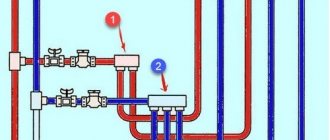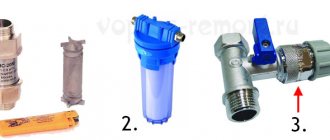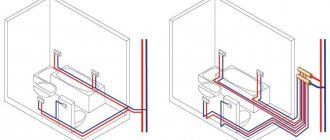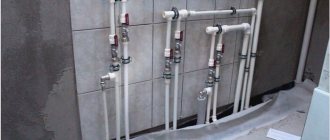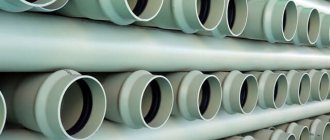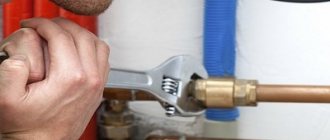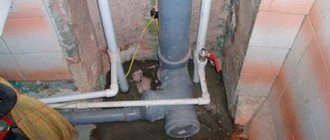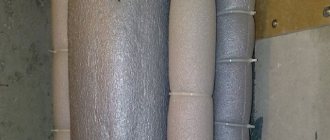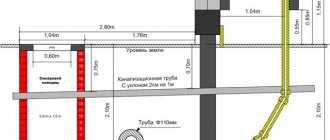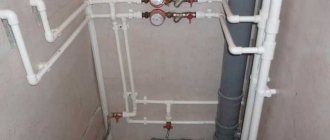What is a collector water supply scheme
A collector water supply scheme is the distribution (laying) of water pipes from a single distribution device to each water consumer (plumbing device) of the apartment independently of each other. Moreover, each device can be disconnected from the water independently.
At the same time, you need to understand that the apartment essentially has two water pipes. One for cold water (CW) and the second for hot water (DHW).
The device from which the water supply is extended (installed) is called a collector. In the apartment's water supply collector circuit there should be at least two of them, for cold and hot water.
Collectors are installed after the apartment's water supply system in specially made plumbing cabinets.
Typical installation mistakes
Installing a water supply system in an apartment with your own hands in accordance with all modern standards is quite a difficult task for a non-specialist. To avoid most mistakes, professionals recommend:
- install shut-off valves at the entrance to each branch of the system and in front of the plumbing equipment;
- insulate hot water pipes if hidden installation in ceilings or floors is planned;
- during installation, close the openings of uninstalled pipes;
- carry out soldering in a clean room;
- check pipes for moisture and dirt before soldering;
- do not block access to the connecting sections of the system with water supply.
Following these tips will greatly facilitate the work of maintaining and repairing communications.
Advantages and disadvantages of a collector water supply system
Among the undoubted advantages of the collector water supply scheme, I would include
- Ease of maintenance of the water supply system. You can turn off any device independently of others.
- Possibility of connecting new household appliances with pipeline connections without dismantling the existing water supply circuit.
The disadvantages of the collector circuit include the increased cost of plumbing installation work and the consumption of more materials, since a separate pipeline must be connected to the devices.
Also, high-quality water distribution using a collector circuit can only be done during a major renovation of an apartment bathroom.
The main methods of installing water supply in an apartment
There are two main schemes for distributing water supply in an apartment: tee, also known as sequential, and also collector. Both schemes have certain advantages and disadvantages, so they are used for different situations. In addition, sometimes it makes sense to combine both of these schemes.
Method #1. Series (tee) circuit
This is the easiest way to design and implement plumbing in a typical apartment. This scheme consists of one common pipe, to which all devices - consumers of cold tap water - are connected in series. In the same way, a hot water supply system is installed in parallel.
The main pipe must be larger in diameter than the rest of the water supply, since it functions as a collector in this system. Tees are used to connect plumbing fixtures, which is why this scheme is often called a tee.
The advantage of a sequential wiring diagram for the plumbing system in an apartment is that this scheme is very simple and requires minimal implementation costs
The principle of such a system is very simple both for design and implementation. Water supply is organized in a similar way in almost all apartments built according to standard Soviet designs. One of its significant advantages is the small number of water pipes. Therefore, the costs of creating such a water supply system will be minimal.
This diagram demonstrates in sufficient detail the structure and operating principle of a sequential water supply wiring diagram in an apartment, which is also called a tee
But such a plumbing system is only suitable for the small apartments described above with a small amount of plumbing. The fact is that the longer such a system, the lower the water pressure at the end of the pipeline. Plumbing fixtures connected at the end of the system will receive less water and may not function properly.
Problems with a consistent water supply system also arise if a faucet or tank breaks down. During repairs or replacement of plumbing, you will have to shut off the water supply from the supply riser. In small apartments there is one riser (or two hot water supply and hot water supply), here the water is completely shut off.
A serial connection does not allow you to disconnect only one device from the water supply.
When organizing a tee connection scheme, tees with a threaded connection are often used, which should be carefully sealed during installation
Experienced plumbers note a number of other problems associated with servicing tee water supply systems. Connection points are usually hidden under decorative trim and easy access to them is not always available. As a result, when a leak occurs, identifying the problem area becomes difficult.
Very often, to repair the water supply, replace risers or a heated towel rail in the bathroom, you have to dismantle false panels, break down walls, etc. And upon completion of the repair work, it may be necessary to re-perform the decorative finishing of the premises. But despite these shortcomings, the tee water supply system is still in demand today.
This diagram allows you to visualize the set of elements that may be needed when creating a sequential water supply wiring diagram in an apartment
It is considered the optimal solution when designing apartments with a small area. Such housing has a budget price, and the serial connection of plumbing allows you to reduce the cost of its arrangement. At the same time, the pressure in a short-distance water supply system remains quite high.
But in order to reduce the costs not only of creating, but also of operating such a system, you should carefully consider the layout of pipes and tees, ensuring access to them if possible.
Also, do not skimp on plumbing at the expense of the quality of materials. All work must be carried out as best as possible to reduce the likelihood of breakdowns and leaks to a minimum.
Method #2. Beam (collector) version
This wiring diagram is considered the optimal choice for large apartments, as well as where a large number of plumbing fixtures are to be installed. A special feature of this type of wiring is the presence of a collector. Water from the common riser is supplied first to the collector, and then to consumers, i.e. to plumbing fixtures.
This diagram clearly shows the design of the collector version of the water supply distribution in the apartment. The main flow of water is discharged to a collector, to which each piece of plumbing is connected separately
Each consumer is connected separately, and not sequentially, as in the tee system described earlier. One of the main advantages of a collector water supply system is the uniform distribution of water throughout the system.
This means that the number of connected devices and the length of water pipes do not reduce the pressure in the system for one of the consumers.
In terms of design, a water supply manifold is a relatively simple device. If desired, you can select and install it yourself
Another advantage of the collector system is the ability, in the event of a breakdown, to disconnect only one plumbing fixture, and not the entire water supply in the apartment, as happens with a series connection. The same circumstance allows you to personalize the characteristics of the plumbing system for each specific device.
To do this, the necessary devices are installed between the collector and the device, for example, filters, gearboxes, etc. The water pressure in the system can be influenced: the flow of water can be increased or, conversely, reduced, cleared of impurities or saturated with useful substances, etc. The disadvantages of the collector wiring diagram include the high costs of its creation.
You will need significantly more water pipes than when implementing a tee scheme. In addition, such a system is more complex; an inexperienced plumber may encounter problems already at the design stage.
To make a collector connection, you must first select a location for the collector from which the cold water flow will be distributed.
The same device will be needed if hot water supply in the apartment is also provided centrally. The hot water collector is installed separately.
Water pipes are laid between the collectors and the common riser, on which a shut-off valve must be installed. It will allow, if necessary, to completely shut off the supply of hot and/or cold water to the apartment.
Depending on the situation, additional elements may be installed on this section of the water supply system, for example, coarse filters or electric taps for an emergency leak protection system. When the collectors are installed, pipes are supplied from them to each plumbing fixture.
Sinks, bathtubs, and shower stalls usually require both hot and cold water supplies. But only cold water needs to be supplied to the toilet cistern or automatic washing machine. If the apartment has a water heated towel rail, it is connected to the hot water supply manifold.
Additionally, the system may include filters, reducers and other useful devices. Of course, shut-off valves are installed between the collector and the consumer, allowing the water to be shut off only in this specific area, if such a need arises.
On large areas, it sometimes makes sense to combine a collector and tee wiring diagram. In this case, not one consumer is connected to one of the collector branches, but several, connecting them in series with pipes. As a result, this part of the water supply will have the same disadvantages as any tee circuit.
For example, in the event of a breakdown, this part of the highway will have to be completely disconnected. But sometimes combining wiring diagrams can significantly reduce the cost of installing a water supply system. In addition, such a solution may be optimal for individual design of residential premises.
Water supply collector diagram drawing
The figure below shows a water supply diagram using a collector circuit. This is a common option offered as an example.
Manifold water supply wiring diagram
See the diagram above.
- 1.3 - Ball valves for heated towel rails;
- 2 - Ball valve to the bypass jumper;
- 4 - Main, emergency ball valve for hot water;
- 5 - Coarse filter;
- 6 - Accounting counter;
- 7 — fine filter with a brass mesh 100 microns;
- 8 - Pressure reducer, for houses without booster pumps;
- 9 - Collector;
- 10 - Main, emergency ball valve for cold water.
Methods for installing a plumbing system
In conditions of limited space, where there are difficulties in placing household appliances in the bathroom, installation of a water supply using a closed method is considered more preferable. In this case, the walls are pre-drilled, where the pipes are later laid. This approach allows you to hide the presence of pipes in the room; they are located under the finishing coating. Pipes made of copper, metal-plastic, PVC with pressed transitions should be installed inside the walls.
Attention! Concealed installation is not recommended when installing systems with detachable connections. Installation of some types of fittings and transition couplings is carried out only in the open way. This ensures constant access to them if repairs are necessary.
Advantages of hidden installation:
- preservation of usable space, the ability to place plumbing fixtures directly to the walls;
- maintaining an aesthetic appearance - achieved by hiding the water supply under the wall covering;
- maintaining the integrity of plastic pipes in case of fire.
Disadvantages of the method:
- lack of possibility to use steel;
- high price;
- complexity of installation when using permanent connections;
- the need for repairs after eliminating each malfunction of the plumbing system;
- risk of damage to the water supply when drilling a wall surface;
- inability to check and eliminate leaks in the water supply system.
Installing a pipeline in grooves has a large number of disadvantages. They are mainly associated with the need for high costs when repairing walls. The procedure for eliminating a leak and replacing a pipeline requires significant investment.
Advantages of installing wiring in an open way:
- the ability to use pipes made of different materials;
- the ability to quickly detect leaks;
- ease of installation, saving time due to the absence of the need for chiselling of walls;
- ease of repair;
- the ability to connect an additional line without the need for gating and repairs.
Disadvantages of the method:
- limitation of usable area;
- risk of damage to the water supply system in the event of a fire.
Attention! The open method of wiring installation has fewer disadvantages. When choosing a suitable method, calculations should be made in advance.
What is a collector
A manifold, or comb, is a plumbing device that has one input and several outputs. Control valves are installed at each outlet to change and shut off the water flow. Copper, steel, polymer, and metal-plastic water pipes can be connected to the collectors.
Manifolds are available with the ability to connect water supply from both sides. During installation, one input is plugged. Collectors are available with different numbers of leads. The most common collectors are 2,3,4,5,7 pins. Manufacturers are very diverse. Depending on the company, the price and quality of collectors differ. Here is a list of manifold manufacturers selling in Russia:
- VALTEC Russia;
- Italian company Far;
- German Rehau;
- Italian Tiemme;
- Italian Luxor;
- UNI-FITT Italy;
- Polish Solomon.
Features of choosing material for pipes
For a long time, only metal pipes were used in the manufacture of pipes. Today they are gradually being replaced by plastic, which is explained by the numerous advantages of such pipes. When installing the pipeline, PVC and metal-plastic are also used. They are used when installing a new water supply system and when replacing an old one.
Material for making pipes, their properties:
- Polyethylene pipes are easy to install; welding is used during the work. The service life of products can reach 30 years. Pipes are available at an affordable price. The main disadvantages are considered to be low ductility and instability to high temperatures. When installing hot water pipes, more expensive cross-linked polyethylene is used.
- Metal-plastic products - service life can reach 30 years. The pipes bend easily and are resistant to corrosion. The main disadvantage is considered to be instability to elevated temperatures, the maximum value reaches 95 degrees.
- Polypropylene pipes are characterized by versatility; they will last up to 50 years. When arranging hot water supply, preference should be given to reinforced models.
When choosing a material, the following factors should be taken into account:
- installation method;
- the ability to do the work yourself;
- cost of materials, installation.
Operating principle of a water supply collector circuit
The operating principle of the water supply collector circuit is very simple. Water under pressure enters the manifold and is distributed through the outlet outlets. Each collector outlet has its own control or shut-off valve.
Collector shut-off valves, theoretically, do not regulate the water supply pressure into the apartment’s water supply system. The water is completely shut off in half a turn. Such valves are designed for about 4000 cycles, turning off and on.
Control valves can regulate the flow of water, like a faucet faucet. A very convenient thing, especially if your house has strong water pressure. Rated for 8000 cycles.
Features of the tee circuit
The essence of this method of water supply wiring is the serial connection of the elements of plumbing communications in the apartment, that is, one pipeline leads from the riser, to which other devices that consume water are connected through tees.
Advantages of the tee method:
- cost savings - the number of connecting fittings is reduced to a minimum;
- easy installation job.
The method has its disadvantages:
- difficult to find leaks due to the large number of connections;
- high probability of a change in the system pressure level, and therefore a decrease in the current water pressure in pipelines remote from the riser;
- during repairs, it is necessary to turn off all water supply;
- inconvenient installation of water supply in an apartment when the room has a small area.
Several nearby consumption points reduce the risk of pressure surges. During installation, as a rule, hidden installation of tees is chosen, as a result of which inspection and repair of communications is difficult.
